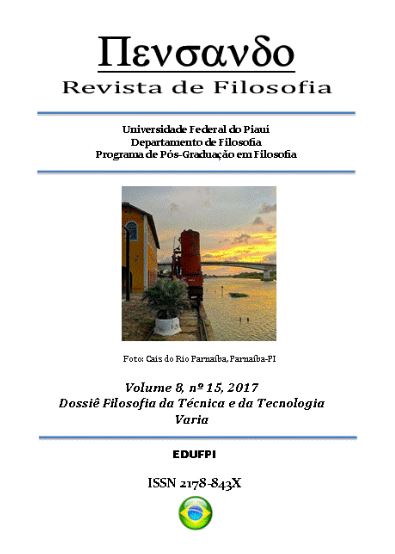O DESIGN COMO UM MODELO METODOLÓGICO PARA A TECNOLOGIA
DOI:
https://doi.org/10.26694/pensando.v8i15.5418Palavras-chave:
design, metodologia, tecnologia, explicaçãoResumo
O objetivo desse artigo consiste em realizar uma investigação filosófica sobre o design, buscando encontrar elementos que permitam caracterizá-lo como um modelo metodológico próprio das áreas tecnológicas. O ponto de partida consiste em caracterizar a natureza dos problemas tecnológicos, diferenciando-os, consequentemente, dos problemas científicos. Em seguida, tratamos de apresentar algumas características peculiares do próprio design que lhe dão identidade. Na sequência, procuramos demonstrar que o design é um processo, ou seja, um conjunto de atividades ordenado e racional que tem como ponto de partida a identificação de um problema tecnológico e busca solucioná-lo, desenvolvendo um artefato ou um dispositivo que seja funcional. Por fim, consideramos que o design também consegue fornecer uma explicação tecnológica, desvendando alguns dos elementos obscuros que perpassam o processo de criação e de uso dos artefatos tecnológicos.
Referências
BUNGE, Mario. Seudociência y ideologia. Madri: Alianza Editorial, 1985.
_______. Epistemologia: curso de especialização. São Paulo: Ed. da Universidade de São Paulo: 1980.
CROSS, Nigel. Designerly Ways of Knowing. London: Springer-Verlag, 2006.
____________. Engineergin design methods: strategies for product design. England. 4a ed. John Wiley & Sons Ltd, 2005.
DAHL, D. The importance of visualisation in concept design. In: Design Studies. N. 22, 2001, p. 5-25
DORST, K; DIJKHUIS, J. Comparing paradigms for describing design activity. In: Design Studies. N. 16, 1995, p. 261-274.
DYM, C. L; BROWN, D. C. Engineering design: representation and reasoning. 2ª ed. Cambridge: Cambridge University Press, 2012.
DORST, Kees. OVERVELD, Kess van. Typologies of design practice. In: MEIJERS, Anthonie W.M. (Editor) Philosophy of technology and engineering sciences (Handbook of the philosophy of science). Amsterdam, Elsevier, 2009.
EEKELS, J. A methodological comparison of structures of scientific research and engineering design: their similarities and differences. In: Design studies: Vol 12, N. 4, October, 1991.
GLEGG, Gordon L. The design of design. Cambrige/London/New York/Melbourne: Cambrige University Press, 1969.
HUGHES, Jesse. Practical reasoning and engineering. In: MEIJERS, Anthonie W.M. (Editor) Philosophy of technology and engineering sciences (Handbook of the philosophy of science). Amsterdam, Elsevier, 2009
KROES, Peter. Design methodology and the nature of technical artefacts. In: Design Studies. N. 23, 2002, p. 287-302.
__________. Technological explanations: the relation between structure and function of technological objects. In Technè, v. 3, n. 3, Spring 1998. Disponível em: <http://scholar.lib.vt.edu/ejournals/SPT/v3n3/KROES.html>. Acesso em março de 2010.
KROES, Peter. MEIJERS, Anthonie. Special Issue – The dual nature of technical artefacts. In: Studies in history and philosophy of science. Elsevier, Vol 37, N. 1, 2006.
KROES, P; FRANSSEN, M; BUCCIARELLI, L. Rationality in design. In: In: MEIJERS, Anthonie W.M. (Editor) Philosophy of technology and engineering sciences (Handbook of the philosophy of science). Amsterdam, Elsevier, 2009
PITT, Joseph C. Technological explanation. In: MEIJERS, Anthonie W.M. (Editor) Philosophy of technology and engineering sciences (Handbook of the philosophy of science). Amsterdam, Elsevier, 2009.
SIMON, H. A. Sciences of the artificial. Cambrigde: MIT Press, 1992.
SCHÖN, D. A. The reflective practitioner. USA: Haper Collins, 1983.
VERMAAS, Pieter et al. A philosophy of technology: from technical artefacts to sociotechnical systems. Morgan & Claypool, Eindhoven University of technology, 2011.
_________et al. Philosophy and design: from engineering to architecture. Springer, 2008.
VINCENTI, Walter. What engineers know and how they know it. Analytical Studies from Aeronautical History. London: The John Hopkins University Press, 1990.
De VRIES, Marc J. Translating customer requirements into technical specifications. In: MEIJERS, Anthonie W.M. (Editor) Philosophy of technology and engineering sciences (Handbook of the philosophy of science). Amsterdam, Elsevier, 2009.

























